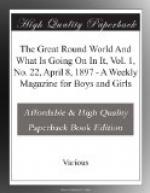When the Goths flowed in a rough torrent over Southern Europe they effaced civilization. But this Saracen wave of conquest bore on its crest—but only on its crest—art, refinements, and culture of a type unknown to Europe. The twilight of the Middle Ages was illumined by a revival of Greek culture at Constantinople, and by Saracenic art and erudition in Spain.
For seven hundred years they remained in Spain, which still bears traces of their beautiful architecture; and the Middle Ages would have been darker still but for the enriching stores of knowledge brought into Europe by the Asiatic people.
So in the 8th century there were two great empires in Europe: the Roman and the Mahometan.
The one had passed its meridian and was swiftly declining. The other, with irresistible energy, and with the vigor of a terrible youth, made men tremble for the fate of Christendom.
This Saracen Empire now stretched from the heart of Asia to the outer confines of Europe. So, like the Roman, it was divided into its Eastern and Western parts with two Caliphs (or Emperors): one at Bagdad, in Asia and the other at Cordova in Spain.
A part of their possessions in the East was the spot the most sacred in the world to Christians. Palestine, the land hallowed by the birth, life, and death of Christ, was held by these infidels, whose religion required them to insult and degrade the very name of Christ, and offered rich rewards for exterminating His followers.
This led to the most heroic event in all history. The annals of the world record nothing more astonishing than the Crusades.
When one man offers up fortune and life for a sentiment, he is regarded as one different from his fellows. If an entire nation does it, it is still more amazing. But that all the nations of a Continent, forgetting their own private ambitions and interests, laying aside enmities and jealousies among themselves, should unite, and for two centuries pour out life and treasure, and expend all their energies upon an object which could bring nothing but sacrifice—no material reward,—this is a spectacle the world has seen but once, will never see again, and will never cease to wonder at!
When Peter the Hermit came from Jerusalem at the close of the eleventh century, and with burning eloquence told of the desecration of the Holy Places in Palestine, and of the sufferings of the small band of Christians in the Holy City, Europe rose as one man.
From sovereign to serf there was not one dissenting voice. If it took uncounted lives, and all the treasure of Europe, the Cross, and not the Crescent, should wave over the Holy Land.
The kingdoms united in one great “European Concert.” And for what purpose? To drive the Mahometans out of that very land where another “European Concert” is ingeniously striving to keep them undisturbed to-day, and to rescue a little handful of Christians counted by units, where now they call to us by thousands!




